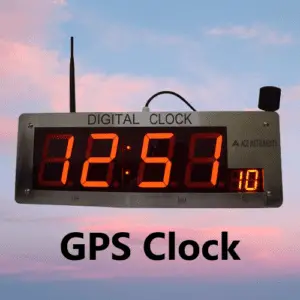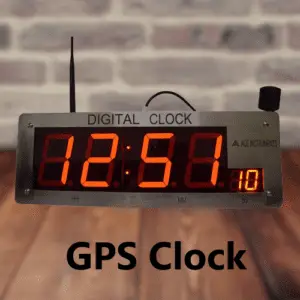A GPS clock, short for Global Positioning System clock, is a specialized timekeeping device that utilizes signals transmitted by GPS satellites to maintain accurate and precise time synchronization. It combines the functionalities of a standard clock with the ability to receive signals from GPS satellites orbiting the Earth.
What is GPS clock
GPS clocks operate based on the principle of triangulation. Multiple GPS satellites continuously broadcast signals that include precise time information derived from onboard atomic clocks. By receiving signals from several satellites simultaneously, a GPS clock can determine its position by calculating the time differences between the signals. This position calculation allows the clock to synchronize its internal timekeeping mechanism with Coordinated Universal Time (UTC), which is the global standard for timekeeping.
The precision of GPS clocks is achieved through the exceptional accuracy of the atomic clocks onboard the GPS satellites. These atomic clocks rely on the properties of atoms to measure time, providing an incredibly stable and precise time reference. By receiving signals from multiple satellites and performing complex calculations, GPS clocks can account for factors such as time dilation caused by gravity and satellite velocities, ensuring that the displayed time remains accurate and aligned with Earth’s frame of reference.
GPS clocks find applications in various fields where precise time synchronization is critical. They are widely used in communication networks to facilitate data transmission and coordination, as well as in financial systems for timestamping transactions. Additionally, GPS clocks play a vital role in scientific research, enabling accurate timing for experiments and data collection. They are also employed in transportation systems, such as air traffic control, railway networks, and maritime navigation, where precise timing is essential for ensuring safety and efficiency.
GPS clock circuit & Critical Components
| Component | Description |
|---|---|
| GPS Receiver | Receives signals from GPS satellites and extracts precise time and positioning information. |
| Microcontroller | Controls the operation of the GPS clock, processes GPS data, and manages time synchronization. |
| Crystal Oscillator | Provides a stable clock signal for timekeeping purposes. |
| Real-Time Clock (RTC) | Maintains accurate timekeeping even when the GPS signal is unavailable or weak. |
| Antenna | Collects GPS signals from satellites for the GPS receiver. |
| Power Supply | Provides the necessary electrical power to operate the GPS clock circuit. |
| Display | Presents the synchronized time and other relevant information to the user. |
| Control Interface | Allows user interaction with the GPS clock, such as setting time or adjusting settings. |
| Memory | Stores configuration data, historical data, or user-defined settings. |
| Communication Ports | Enables connectivity for data exchange with external devices or networks. |
How GPS clock time synchronization?
Time synchronization in a GPS clock is achieved through a series of steps that involve the reception and processing of signals from GPS satellites. Here’s an overview of how GPS clocks synchronize time:
- Signal Reception: The GPS clock receives signals from multiple GPS satellites via an antenna. These signals contain precise time information from the atomic clocks onboard the satellites.
- Data Extraction: The GPS receiver in the clock extracts the time and positioning data from the received signals. It analyzes the signals from multiple satellites to determine the time differences and calculate the clock’s position on Earth.
- Time Calculation: Using the time data from multiple satellites and the calculated position, the GPS clock performs complex calculations to synchronize its internal timekeeping mechanism with Coordinated Universal Time (UTC). UTC is a global time standard based on atomic clocks.
- Compensation for Time Dilation: GPS clocks account for the relativistic effects of time dilation caused by the satellites’ high velocities and the influence of gravity. The clocks make adjustments to ensure that the displayed time aligns with Earth’s frame of reference.
- Time Synchronization: Once the GPS clock has calculated and adjusted the time based on the received signals, it synchronizes its internal clock with the determined time. This synchronization ensures that the clock displays accurate and precise time information.
- Continuous Updates: GPS clocks continually receive signals from Global Positioning System satellites to maintain accurate time synchronization. By periodically updating and recalculating the time based on the signals, the clock ensures ongoing accuracy.

Applications of GPS clock
| Application | Description |
|---|---|
| Communication Networks | Ensures synchronized timing for data transmission and coordination, reducing delays and enhancing network performance. |
| Financial Systems | Provides accurate timekeeping for timestamping transactions, maintains chronological integrity, and facilitates audit trails. |
| Scientific Research | Enables precise timing for experiments, data collection, and synchronization of distributed sensor networks. |
| Transportation Systems | Facilitates accurate timing for air traffic control systems, railway networks, maritime navigation, and synchronization of transportation schedules. |
| Power Grid Management | Supports synchronization in smart grid systems, enabling efficient coordination of power generation, distribution, and demand response. |
| Data Centers | Ensures coordinated timing among servers and networks, enabling reliable data processing, synchronization, and backup operations. |
| Physical Security | Facilitates synchronized time-based security systems, such as access control, surveillance, and event logging. |
| Industrial Automation | Provides precise timing for synchronized operations in manufacturing processes, robotics, and control systems. |
| Mobile Networks | Supports accurate timing for cellular networks, enabling seamless handovers, synchronization between base stations, and efficient resource allocation. |
| Satellite Navigation | Aids in time synchronization for satellite-based positioning systems like Global Positioning System, GLONASS, Galileo, and BeiDou. |
Frequently Asked Questions
What is a GPS clock?
Answer: A Global Positioning Systemclock is a specialized timekeeping device that utilizes signals from Global Positioning Systemsatellites to maintain accurate and precise time synchronization.
How does a GPS clock synchronize time?
Answer: A Global Positioning System clock synchronizes time by receiving signals from multiple Global Positioning System satellites, extracting precise time information, and adjusting its internal clock to align with Coordinated Universal Time (UTC).

What components are typically found in a GPS clock circuit?
Answer: Common components include a Global Positioning System receiver, microcontroller, crystal oscillator, real-time clock (RTC), antenna, power supply, display, control interface, memory, and communication ports.
How does a GPS clock compensate for time dilation?
Answer: Global Positioning System clocks account for the relativistic effects of time dilation by making adjustments based on the satellites’ high velocities and the influence of gravity to ensure accurate timekeeping.
Can a GPS clock synchronize time in indoor environments?
Answer: In indoor environments with limited satellite visibility, Global Positioning System clocks may rely on alternative methods like a backup real-time clock (RTC) or synchronizing with external time references through other means like network connections.
What is the accuracy of a GPS clock?
Answer: Global Positioning System clocks can achieve high levels of accuracy, typically within a few nanoseconds or better, depending on the quality of the Global Positioning System receiver and the precision of the onboard atomic clocks in the satellites.
Can a GPS clock function without an internet connection?
Answer: Yes, a Global Positioning System clock can operate independently without an internet connection as it relies on receiving signals directly from Global Positioning System satellites for time synchronization.
How many GPS satellites are required for accurate time synchronization?
Answer: Global Positioning System clocks typically require signals from a minimum of four GPS satellites to accurately determine both time and position.
What is the update rate of a GPS clock?
Answer: Global Positioning System clocks generally receive and update their time synchronization information once every second, ensuring continuous accuracy.
Can GPS clocks be affected by signal interference or obstructions?
Answer: Yes, signal interference from atmospheric conditions or physical obstructions can impact signal reception and potentially affect the accuracy of Global Positioning Systemclocks. However, advancements in technology and alternative positioning systems help mitigate such challenges.
How long does it take for a GPS clock to initially synchronize time?
Answer: The time required for a Global Positioning Systemclock to initially synchronize can vary, but typically it takes a few minutes to establish accurate time synchronization when first powered on.
Can a GPS clock be used as a standalone time source?
Answer: Yes, Global Positioning System clocks can serve as reliable standalone time sources, providing accurate timekeeping without the need for external references.
Is there a limit to the distance over which a GPS clock can synchronize time?
Answer: Global Positioning System clocks can synchronize time over vast distances as long as there is a clear line of sight to the GPS satellites and an unobstructed signal reception.
Can a GPS clock be used in mobile or portable applications?
Answer: Yes, Global Positioning System clocks can be designed for mobile or portable applications, allowing for accurate time synchronization even when moving between locations.
What are some potential future advancements in GPS clock technology?
Answer: Future advancements may include improved signal reception in challenging environments, enhanced integration with other positioning systems, increased precision in atomic clocks, and the integration of advanced algorithms for better time synchronization performance.
You may also read about Environmental Monitoring


